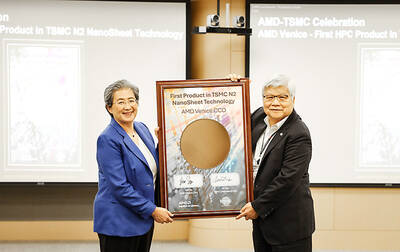Chinese banks are preparing to take advantage of any easing of government restrictions to challenge the likes of Citic Securities Co (中信證券) and China International Capital Corp (中金公司) in the nation’s booming brokerage industry.
Industrial Bank Co (興業銀行) plans to acquire Huafu Securities Co (華福證券), while Bank of Communications Co (交通銀行) wants to purchase Royal Bank of Scotland Group PLC’s (RBS) stake in Hua Ying Securities Co (華英證券), people familiar with the matters said yesterday. They asked not to be identified as the deliberations are private.
The banks’ plans highlight a looming shakeup for China’s brokerages, which numbered 120 last year and have been protected for years by government restrictions on new entrants. Shares of securities firms tumbled yesterday in Chinese stock markets after the industry regulator said banks might be allowed in, while Industrial Bank rallied the most since 2013.
“Brokerages will come under heavy pressure if banks are allowed to enter,” Huatai Securities Co (華泰證券) Shenzhen-based analyst Luo Yi (羅毅) said. “It will lead to cutthroat competition, as banks control most of the financial resources.”
Industrial Bank closed 8.7 percent higher in Shanghai after Bloomberg News reported on its purchase plan. Citic, the largest Chinese brokerage by market value, slid by as much as 4.7 percent in Shanghai before closing down 1.6 percent. News of the Bank of Communication’s plan broke after the market closed.
Asia’s biggest stock market and swelling brokerage profits might be draws for banks that face challenges, including Beijing’s plans to deregulate interest rates, further intensifying competition for deposits. Citic reported a doubling of net income last year.
Chinese brokerages’ assets doubled last year to 4.09 trillion yuan (US$652.93 billion), according to the securities association, as trading volumes reached records.
While the market has fallen this year amid government efforts to rein in an explosion in margin financing, the Shanghai Composite Index remains up 65 percent for the past 12 months.
China’s securities regulator on Friday said that it was studying a proposal to let banks apply for brokerage licenses, without giving any timetable for a decision.
Bank of China Ltd is the only Chinese bank that owns a domestic securities firm, through its Hong Kong-based brokerage unit. Bank of China International (China) Ltd was established in 2002.
Industrial Bank said it is aware of the securities regulator’s announcement and is “studying a related plan,” without giving details. Spokesmen for the Bank of Communications, Hua Ying and RBS declined to comment.
Chinese brokerages accounted for 0.8 percent of China’s 192.9 trillion yuan in financial assets at the end of 2013, compared with lenders’ 78 percent share, according to central bank data.
“Allowing banks to enter the securities business will be devastating to Chinese brokers,” Capital Securities Corp (群益證券) Shanghai-based analyst Zheng Chunming (鄭春明) said. “It may be an exaggeration to draw an analogy to elephants and ants, but that gives you the idea of the impact — the damage to brokerages is significantly more than the benefit to banks.”
Zheng said that the government might be “very, very cautious in giving the approval.”
Industrial Bank and Bank of Communications would probably be among the first banks to take advantage of any opening up of the brokerage industry, China International Capital said in a report. At the same time, such a move is unlikely this year, with the government set to first allow lenders to move into areas such as investment banking, the firm said.

TAKING STOCK: A Taiwanese cookware firm in Vietnam urged customers to assess inventory or place orders early so shipments can reach the US while tariffs are paused Taiwanese businesses in Vietnam are exploring alternatives after the White House imposed a 46 percent import duty on Vietnamese goods, following US President Donald Trump’s announcement of “reciprocal” tariffs on the US’ trading partners. Lo Shih-liang (羅世良), chairman of Brico Industry Co (裕茂工業), a Taiwanese company that manufactures cast iron cookware and stove components in Vietnam, said that more than 40 percent of his business was tied to the US market, describing the constant US policy shifts as an emotional roller coaster. “I work during the day and stay up all night watching the news. I’ve been following US news until 3am

UNCERTAINTY: Innolux activated a stringent supply chain management mechanism, as it did during the COVID-19 pandemic, to ensure optimal inventory levels for customers Flat-panel display makers AUO Corp (友達) and Innolux Corp (群創) yesterday said that about 12 to 20 percent of their display business is at risk of potential US tariffs and that they would relocate production or shipment destinations to mitigate the levies’ effects. US tariffs would have a direct impact of US$200 million on AUO’s revenue, company chairman Paul Peng (彭雙浪) told reporters on the sidelines of the Touch Taiwan trade show in Taipei yesterday. That would make up about 12 percent of the company’s overall revenue. To cope with the tariff uncertainty, AUO plans to allocate its production to manufacturing facilities in

Six years ago, LVMH’s billionaire CEO Bernard Arnault and US President Donald Trump cut the blue ribbon on a factory in rural Texas that would make designer handbags for Louis Vuitton, one of the world’s best-known luxury brands. However, since the high-profile opening, the factory has faced a host of problems limiting production, 11 former Louis Vuitton employees said. The site has consistently ranked among the worst-performing for Louis Vuitton globally, “significantly” underperforming other facilities, said three former Louis Vuitton workers and a senior industry source, who cited internal rankings shared with staff. The plant’s problems — which have not

COLLABORATION: Given Taiwan’s key position in global supply chains, the US firm is discussing strategies with local partners and clients to deal with global uncertainties Advanced Micro Devices Inc (AMD) yesterday said it is meeting with local ecosystem partners, including Taiwan Semiconductor Manufacturing Co (TSMC, 台積電), to discuss strategies, including long-term manufacturing, to navigate uncertainties such as US tariffs, as Taiwan occupies an important position in global supply chains. AMD chief executive officer Lisa Su (蘇姿丰) told reporters that Taiwan is an important part of the chip designer’s ecosystem and she is discussing with partners and customers in Taiwan to forge strong collaborations on different areas during this critical period. AMD has just become the first artificial-intelligence (AI) server chip customer of TSMC to utilize its advanced